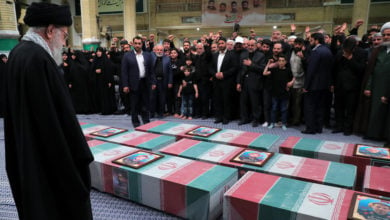The large street protests in Iran following the June 12 presidential elections are seen by U.S. imperialism as a potential political opening.
|
A primary objective of Washington is to overthrow the Iranian government and replace it with a proxy regime. But that is a very difficult task given the evolved social and political reality that has changed Iran in the three decades since the overthrow of the U.S.-backed monarchy in 1979.
Following the election, the campaign of Mir-Hossein Mousavi immediately declared that they lost because of voter fraud. It has been repeated over and over again in the western media that there was no way that President Mahmoud Ahmadinejad could have won by such a wide margin.
Washington’s agenda, however, is not motivated by any actual evidence of fraud, but its own imperatives in the region.
Three days after the election, the U.S. State Department took the unprecedented step of “requesting” that the social networking site Twitter not proceed with a scheduled maintenance of its global network, which would have cut off service at the moment that Mousavi supporters were using Twitter to mobilize for a scheduled street protest in Tehran. The bosses at Twitter quickly complied with the State Department request.
This was not the first time that Twitter collaborated with the U.S. government. In May, the Obama administration flew the Twitter executives into Iraq to assist the occupation forces there.
On June 17, the Iranian government accused the United States and the Obama administration of “intolerable” meddling in its internal affairs following the June 12 Iranian presidential election. Following the third straight day of large street protests, the Iranian government asserted that the United States was fueling the post-election street protests.
The street protests in Tehran are not caused by an intervention from foreign powers. But the United States and other western countries are sympathetic to and encouraging the protests, and see in them an opportunity for advancing their regional objectives. Moreover, the U.S. government has been spending tens of millions of dollars to destabilize the Ahmadinejad government. On May 22, 2007, ABC News reported that “President Bush signed a ‘nonlethal presidential finding’ that puts into motion a CIA plan that reportedly includes a coordinated campaign of propaganda, disinformation and manipulation of Iran’s currency and international financial transactions.” There is no evidence that Obama rescinded that “presidential finding” or the covert destabilization operation.
The class character of the protest movement must be examined by progressive forces, just as it is by the imperialist establishment.
The fact that the movement is dominated by the middle classes and the more affluent, especially in Tehran but in other cities as well, is considered to be of decisive importance in the calculations of imperialism. Washington knows that this movement has genuine energy and initiative and is also linked to the most pro-western wing of the clerical establishment—those who favor capitalist globalization, privatization and a reorientation of Iran’s foreign policy.
Iran in the eyes of the U.S. imperialist establishment
Until the 1979 revolution destroyed the regime of the Shah, Iran was the principal partner of the United States in the Middle East with the exception of Israel.
The so-called Nixon Doctrine outlined a strategy for control and policing of the Middle East that was premised on a U.S.-Israeli-Iranian axis. Of course, this was a partnership based on hegemonic control by one of the three “partners.”
Washington “lost” Iran totally when the monarchy shattered in 1979. U.S. officials and military forces were expelled. The vast CIA spy posts that were located along the 1,000 mile-long Iranian-Soviet border were shut down.
The people’s revolution upset all of the U.S. institutional networks of control and led to a major shift in U.S. foreign policy. The centrality of Iran to U.S. regional domination in the oil-rich Gulf region prior to 1979 cannot be overestimated.
More than anything, the U.S. government feared that Iran’s “Islamic revolution” would soon sweep away the Saudi monarchy as well. Saudi Arabia was the largest producer of oil in the region and a U.S. puppet that survived only with the support of its patron in Washington.
Intent on weakening—or at least diverting—the Iranian revolution, U.S. imperialism encouraged the Saddam Hussein-led government in Iraq to invade Iran in 1980. An eight-year-long war between Iran and Iraq was decisive in weakening both governments. The Pentagon and CIA provided overt and covert finances, weapons and intelligence to both sides.
Immediate U.S. objectives
Like the administrations that preceded it, the George W. Bush administration sought to destroy the governments in Iraq and Iran, replace them with proxy regimes and thus achieve U.S. hegemony over the Persian/Arabian Gulf area. This is the long term goal of the current administration as well. The global ambitions of U.S. imperialism, especially the focused goal of domination over the oil-rich Middle East, do not change one iota when the Democrats replace the Republicans in the White House or vice versa. The U.S. intervention in the current struggle inside of Iran is entirely anchored to this strategic orientation.
As Marxists, we must shatter the myth that the U.S. capitalist class and its agents in the mass media care at all about freedom and democracy. That is a sham. People will always be deceived unless they decipher the class essence masked by these flowery themes. The vicious character of imperialism is camouflaged by those most high sounding phrases about human freedom.
The U.S. government and corporate media do not care about the sanctity of elections. When the people of Gaza voted for a Hamas-led government, they were punished with economic sanctions designed to starve them, deprive them of employment and suspend access to medicine. Across the Gulf from Iran is the world’s biggest oil producer, Saudi Arabia, under the domination of Washington and Wall Street. Saudi Arabia is ruled by a hereditary royal family and has never held an election.
The goal of U.S. imperialism is to subvert and overthrow the Iranian government and find a replacement that is friendlier or more acquiescent to imperialism’s designs to dominate the oil-rich Gulf area. If it cannot achieve all that at once, Washington will be somewhat satisfied by the internal weakening of Iran, which would reduce its influence as a regional power. Neutralizing Iran would also further isolate Hamas, Hezbollah and other resistance forces in the Middle East.
The Islamic Republic of Iran is a bourgeois nationalist regime. It has earned the enduring enmity of U.S. imperialism—but not because it is an “Islamic Republic.” Iran has not “gone socialist” or otherwise desecrated the institutions of capitalism so revered by the imperialists. The source of the conflict is that Iran, after the 1979 revolution, emerged as an independent country and expelled the United States from its position of dominance in the country’s internal affairs and over its natural resources, especially its oil.
In its first decade, during the period that Mr. Hossein Mousavi was Prime Minister (1981 to 1988), the government of the Islamic Republic severely repressed Iran’s left wing parties and organizations.
Mousavi challenged Ahmadinejad for the presidency in the June 2009 election. His candidacy called for accelerating the process of privatizing nationalized and publicly-owned enterprises, and reducing social insurance programs and subsidies aimed at helping the urban and rural poor. He also called for liberalizing some of the social strictures of the Islamic Republic. His political base was primarily among the middle and upper middle classes, and the more affluent and western-oriented sectors of society.
Mousavi may be something of an accidental or transient figure in the current political crisis. What is important in U.S. calculations at this juncture is not Mousavi per se but rather the street-based protest movement dominated by the middle classes. These classes include shop owners, professionals, well-to-do university students and other privileged sectors who are often mobilized in the service of reaction.
An urban-based movement of the middle classes, especially among a new generation of young people, could serve to de-legitimize the government of the Islamic Republic, not just Ahmadinejad, in the eyes of a larger sector of the population. By throwing its weight behind this movement, Washington is pursuing a time-tested destabilization strategy, in hopes that this could lead to a deepening schism within the ruling organizations and state structures.
If this type of destabilization process does not lead to either a civil war or a collapse of the state structure—both of which may be unlikely, even though they are the preferred option of U.S. imperialism—it could at least lead to a weakening of Iran as a regional power. This, too, would be seen as beneficial for the United States at a time when the Pentagon is vastly overextended by the occupation of Iraq and Afghanistan.
All the Western, corporate-dominated media are demonizing Iran to the hilt. This is part of a global destabilization strategy. The protests are receiving worldwide encouragement.
Based on the very sympathetic media coverage of middle-class students burning buses and destroying property, one might have expected the same media outlets to have encouraged similar, violent street actions in U.S. cities in 2000. After all, Bush lost the election by 500,000 votes and yet five millionaire Supreme Court judges ordered Bush to the White House even though widespread racist disenfranchisement by the Republicans was thoroughly exposed and proven.
McCain, the other Republicans and the Wall Street Journal are condemning Obama for not doing more to publicly denounce “voter fraud” and “repression against street protestors.” What is it about this protest movement that makes the chauvinists and ultra-right wing in the U.S. ruling class embrace it?
For his part, Obama knows that if he openly embraces the protest movement, he will allow the Ahmadinejad forces to depict Mousavi supporters as servants for the same imperialism that imposed the Shah on Iran for 26 years. The Obama Administration and all the western imperialist countries, especially the Sarkozy government in France, are using a multi-faceted and nuanced effort to support the street protests. But the Obama Administration does not want to overplay the U.S. hand in the early days of this struggle.
A footnote from history
In 1953, the CIA engineered a “regime change” against the democratically elected government in Iran. Prime Minister Dr. Mohammad Mossadegh had provoked the ire of the United States and Britain when he nationalized the Anglo-Iranian Oil Company—also known as British Petroleum.
Washington and London responded by imposing economic sanctions on Iran.
The middle classes became disillusioned with the government and provided the human material for the bloody coup in 1953 that took the lives of thousands of people. The Shah of Iran was made monarch. He de-nationalized the oil. He established a 26-year long partnership of brutal suppression with the CIA and the Pentagon. Kermit Roosevelt, who led the CIA coup, was rewarded with the vice-presidency of Gulf Oil, which took over a portion of Iran’s de-nationalized oil fields.
The Western media celebrated the CIA coup against Mossadegh. The New York Times editorialized at the time: “Underdeveloped countries with rich resources now have an object lesson in the heavy cost that must be paid by one of their number which goes berserk with fanatical nationalism.”
The words of the imperialists and their media are of necessity different today than those used in the Times’ editorial, but the sentiment remains the same. The leaders in Washington have never given up their aim of overturning the 1979 revolution and returning Iran to its former position as a neo-colony—just as they did to Iraq in 2003. Progressive people in the United States should remember the role of U.S. imperialism and the class character of the movements it promotes when seeking to understand the dynamics of the street protests in Iran today. Above all, the anti-war and other people’s movements must take a firm stand against all forms of U.S. intervention and in support of Iran’s right to self-determination.







